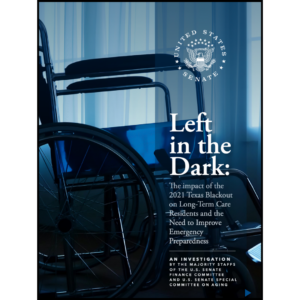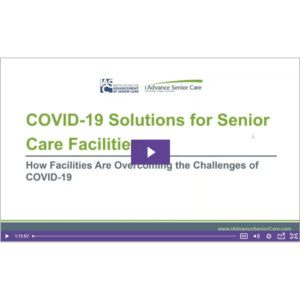The first 24 hours: Best practices for response to serious incidents
An unfortunate reality in the long-term care industry is that even the best-run facilities will suffer their share of adverse events over time. Not everything will always be perfect, mistakes will be made and bad things will happen to good people.
Owners and LTC providers constantly need to evaluate the effectiveness of the policies and procedures in place at their facilities and be proactive in preventing future occurrences and maintaining safe environments. A “just” culture provides a balance that allows for personal accountability for an individual’s actions while learning from a non-punitive examination of the systems that allowed the error to occur in the first place. Facilities should strive for the “just” culture.
While not every prospective incident can be mapped out with anticipated responses and scenarios, there are steps owners and providers can take, especially in the first 24 hours after a serious event, to better protect residents, their families and employees.
FOCUS ON NEEDS OF RESIDENTS AND FAMILY FIRST
Core competencies must always be addressed first. Maintaining a resident- and family-first mentality sets a strong foundation, of which many crucial post-incident decisions will be based.
In the event of a medical emergency, the immediate needs of the resident and their family must remain the focal point. Whether residents require acute medical attention or transfer to another facility, the safety of the resident and disclosure to the family is a top priority.
IT’S OK TO NOT HAVE EVERY ANSWER RIGHT AWAY
One of the most important things for LTC providers and owners to keep in mind during adverse events is to avoid assumptions. Human nature drives us to want to comfort and communicate with families when they are navigating through challenging life events. Offering immediate answers, even when not all of the facts are known, is tempting, but is ultimately a bad decision.
Strive to strike a balance between transparency and giving out too much information. Appoint a person to disclose the information to the family. Conducting a thorough investigation and properly disclosing findings in a timely fashion. This same philosophy needs to be imparted to staff as well since they typically have the most face-to-face contact with the residents and their families.
Significant problems can be made even worse when assumptions are presented as facts. When dealing with family members in these circumstances, there is a natural desire to console the family or resident by responding to all of their questions, even if the investigation is not complete and not all of the facts have come to light. You need to realize and reinforce to your staff that it is okay to not have every answer right off the bat. Being honest, sharing the facts you do have and reassuring the family that an investigation is underway is an acceptable response in the hours following an incident.
The entire administrative team and staff must have consistent messaging, a full understanding of the situation and what the next steps should be. Often times, physicians or other parties may be telling the family or resident something different from the administrative team and visa versa. The situation itself is stressful enough and inconsistency from the people delivering the information to the family or resident only creates unnecessary frustration and liability. This is the reason a point person should be elected to deal directly with the family. One message is being delivered instead of a lot of conflicting stories.
INVESTIGATION: THE FIRST 24 HOURS ARE CRITICAL
Throughout the lifecycle of these types of incidents, there are generally three stages including recognition, response and resolving.
Recognition
Recognition consists of establishing a major response system list, assembling a response team and ensuring there are no gaps in staff training and protocol. Prioritization is key and tasks that must be performed immediately must be identified and others can be put off for a later time. Having these items in order before an incident actually occurs significantly increases the likelihood of selecting and executing the appropriate reactions.
Investigations must begin immediately and it is the responsibility of the response team at the facility to start and manage the process. This team should be comprised of administration, facility leadership and professionals specializing in risk management at the facility. The group, often referred to as Serious Event Response Team (SERT), is specifically tasked for situations like this to maintain order through:
- Proper planning and preparation
- Ensuring consistent messaging
- Instituting a thorough investigative process
- Diligent documentation and notification throughout
- Installing a system of evaluations and follow-up planning
Response
Response is the next stage, encompassing the entire investigative process from start to finish. The SERT must coordinate internal and external meetings, consult medical care professionals and possible third-party investigators, conduct interviews and communicate with the staff, resident(s) and family.
The most challenging part of this process is the interview portion of the investigation as it can be time consuming and mentally draining. The quality of these interviews are often dependent on the experience and skill of the interviewer. Having an unpolished or untrained interviewer can compromise an investigation because they might not ask the right questions and may not give the process the time it deserves.
Occasionally shortcuts are taken to save time, but this can be detrimental to the investigation. Two popular routes are skipping over people completely who should be interviewed or doing a group interview with the entire staff on shift during the time the event took place. These are ineffective practices and could end up burying the true cause of the adverse event. Skipping someone totally eliminates the possibility of their contribution leading to an answer. During group interviews, the scrutiny of questioning is not nearly as intense or thorough as it would be during individual interviews. Time, financial and resource restrictions are understandable, but exhausting every possible lead to identify the root cause is crucial and often helps distinguish the likelihood for legal and non-legal action.
Resolving
Resolve is the final portion of the process and it includes a root cause analysis, anticipation for future medical care, future disclosure and coordinating with claims professionals. Root cause analyses are evaluations designed to drill down to find what system protocols failed and determines recommendations on how to prevent reoccurrences. Taking corrective actions and making adjustments to install accountability and responsibility initiatives is key for the safety of residents and the continued success of the facility.
In many of the situations, no matter the severity, residents and family members are most satisfied with having peace of mind. Acknowledging the event, accepting fault when warranted and reassuring all parties that steps are being taken to protect against similar incidents in the future is usually met by some level of understanding from the family.
Denise Shope serves as a Risk Management Consultant at RCM&D, a privately-held insurance advisory firm based in Baltimore, Md. She specializes in healthcare risk management with expertise in long-term care, tertiary care and physician groups. Contact Shope at dshope@rcmd.com
Related Articles
Topics: Articles , Disaster Preparedness , Executive Leadership , Facility management , Risk Management











